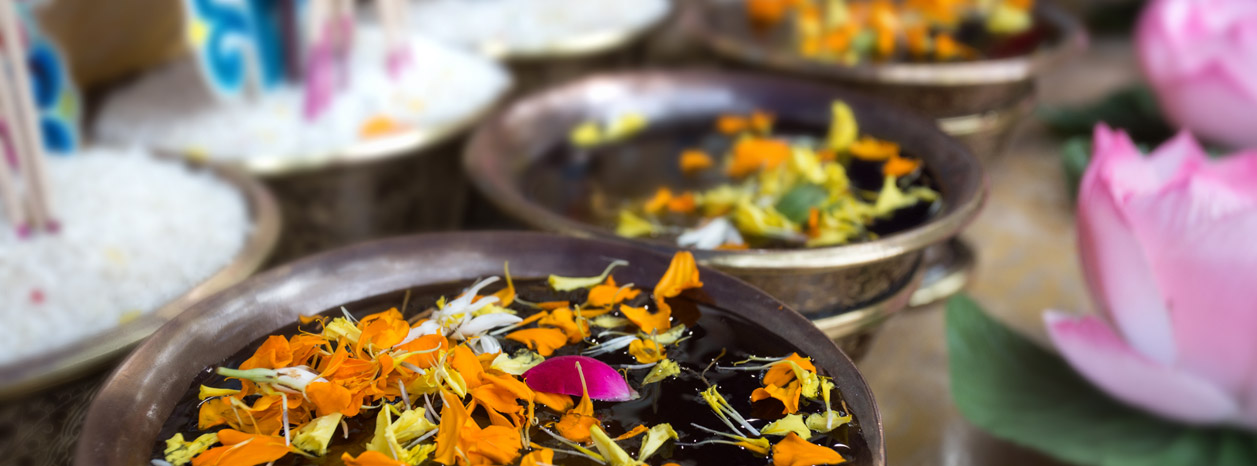
The tradition of coming together for the sake of “aspirations” or “monlams” (Sanskr. praṅidhāna; Tib.: smon lam) celebrates a particular event in the life of Buddha Śākyamuni. In the biography of the Buddha it is recorded that he was once challenged to perform miracles. This took place in Shravasti in the North of nowadays India. During a period of fifteen days the Buddha is said to have shown marvelous manifestations that completely outshined the performance of any of the other spiritual masters who had initiated this contest. Thus the Buddha indirectly demonstrated that his teachings are unparalleled.
In commemoration of this special event, the first “Monlam”-gathering in Tibet is said to have taken place already in the early period of Samye, the first Buddhist monastery in Central Tibet. In the history of Tibetan Buddhism the various lineages and monasteries started to integrate this tradition into their yearly festivities with different emphasis concerning the spiritual practices performed during this period. Often, it was held during the first fifteen days of the New Year. In the Karma Kagyu School, it was the third Karmapa Rangjung Dorje (1284-1339) who initiated the yearly “Monlam”-gathering and during the time of the seventh Karmapa Chodrag Gyamtso (1454-1506) it became one of the most prominent Buddhist festivals in Tibet.
Upon the initiative of the late 14th Kunzig Shamarpa (1951-2014), the first Karma Kagyü Monlam in India took place in Bodhgaya in Dec. 1996 and was led by both, the 14th Kunzig Shamarpa and the 17th Gyalwa Karmapa. Ever since, Bodhgaya – the sacred site in Northern India where approx. 2.500 years ago the Buddha seated under the Bodhi-tree attained perfect enlightenment and where an important part of his relics are kept – became the place for the yearly gathering for the so-called Kagyü-Monlam.
In a sūtra it is recorded that Buddha Śākyamuni advised future Buddhists to visit the four sacred places of pilgrimage. These are Lumbini, the Buddha’s birth place, Bodhgaya, the place where he attained enlightenment, Sarnath, the place where he turned the wheel of dharma for the first time, and Kushinagar, where he passed into Parinirvāṇa. Moreover, it is said that whatever aspiration is practiced at these places will be accomplished and that spiritual practice performed at such places is so powerful that one is able to purify oneself of extremely negative karma.
With the yearly gatherings for the Kagyü-Monlams which are led by the 17th Gyalwa Karmapa Trinley Thaye Dorje since 1996 until today, we do not just have the marvelous benefit of practicing under the Bodhi-tree at this most sacred site of Buddhism, but, on top of it, in the presence of the Gyalwa Karmapa, a great Bodhisattva. Nāgārjuna, one of the most famous Buddhist master of India (2nd c. A.D.) for example said that aspiration prayers practiced together with such highly developed Bodhisattva are so powerful that one is able to purify oneself from negative karma of all kinds. Along with practicing at this sacred place in the company of the Gyalwa Karmapa, the additional benefit is that there is a large number of individuals – both monastic and lay practitioners – who join in this common practice. It is said that the virtue each individual accumulates through his or her own practice, is obtained by each and every individual of the group. Thus the benefit is said to multiply immensely.
During the gathering, emphasis lies on the recitation of an excerpt of the Avataṃsaka-Sūtra, called “The Aspirations of Samantabhadra” which is considered an essential aspect of a bodhisattva’s practice. Along with this throughout the day, various recitations of other aspiration prayers, sūtras and tantras will be performed. At the same time, an individual practitioner can focus on his or her individual practice.
